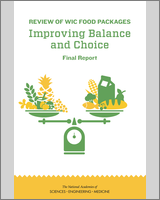From: 2, The WIC Program: Changes Since the Last Review and Continuing Challenges

NCBI Bookshelf. A service of the National Library of Medicine, National Institutes of Health.
| Food Group | Units | Kcal Pattern | |||||
|---|---|---|---|---|---|---|---|
| 1,300a | 2,300b | 2,600 | |||||
| 2005 | 2015–2020 | 2005 | 2015–2020 | 2005 | 2015–2020 | ||
| Fruits | c-eq/d | 1¼ | 1¼ | 2 | 2 | 2 | 2 |
| Vegetables | c-eq/d | 1½ | 1½ | 3 | 3 | 3½ | 3½ |
| Dark green | c-eq/wk | 1½ | 1 | 3 | 2 | 3 | 2½ |
| Red/orange | c-eq/wk | 1 | 3 | 2 | 6 | 2½ | 7 |
| Dry beans and peasc | c-eq/wk | 1 | ½ | 3 | 2 | 3½ | 2½ |
| Starchy | c-eq/wk | 2½ | 3½ | 6 | 6 | 7 | 7 |
| Other | c-eq/wk | 4½ | 2½ | 7 | 5 | 8½ | 5½ |
| Grains | oz-eq/d | 4½ | 4½ | 7½ | 7½ | 9 | 9 |
| Whole grains | oz-eq/d | 2¼ | 2¼ | 3¾ | 3¾ | 4½ | 4½ |
| Other grains | oz-eq/d | 2¼ | 2¼ | 3¾ | 3¾ | 4½ | 4½ |
| Protein Foods d | 3½ | 3½ | 6¼ | 6¼ | 6½ | 6½ | |
| Meat, poultry, eggs | oz-eq/wk | 16½ | 29½ | 31 | |||
| Seafood | oz-eq/wk | 5 | 9½ ↓e | 10 | |||
| Nuts, seeds, soy (oz-eq/wk) | oz-eq/wk | 2½ ↑ e | 5 | 5 | |||
| Dairy | c-eq/d | 2 | 2½ | 3 | 3 | 3 | 3 |
| Oils | g/d | 17 | 17 | 30 | 30 | 34 | 34 |
| Limits for: | |||||||
| Calories for Other Uses f | kcal | 171 | 105 | 326 | 315 | 410 | 380 |
| (% of calories) f | % | 13 | 8 | 14 | 14 | 16 | 15 |
NOTES: c-eq = cup-equivalents; DGA = Dietary Guidelines for Americans; oz-eq = ounce-equivalents.
Serving equivalents for the 1,300-kcal food pattern are the average of the 1,200- and 1,400-kcal patterns.
Serving equivalents for the 2,300-kcal food pattern are the average of the 2,200- and 2,400-kcal patterns.
In the USDA food patterns, dry beans and peas are first counted toward the protein foods group until recommendations for that group are met, then are counted toward the dry beans and peas vegetable subgroup (USDA, 2015).
In 2005, key protein sources were categorized as “lean meats and beans,” without protein subgroups.
An arrow indicates that the recommended food group amount changed from 2010 to 2015–2020 by 1 unit in the specified direction. Other 2015–2020 food pattern amounts are unchanged from 2010.
In 2005, solid fats and added sugars were built into a “discretionary calorie allowance” instead of specific gram levels of intake. These values are shown as a comparator to “calories for other uses” from the 2015–2020 DGA, which include added sugars, alcohol, added refined starches, saturated (solid) fats, or more than the recommended amount of nutrient-dense foods.
SOURCES: USDA/HHS, 2005, 2010, 2016.
From: 2, The WIC Program: Changes Since the Last Review and Continuing Challenges

NCBI Bookshelf. A service of the National Library of Medicine, National Institutes of Health.